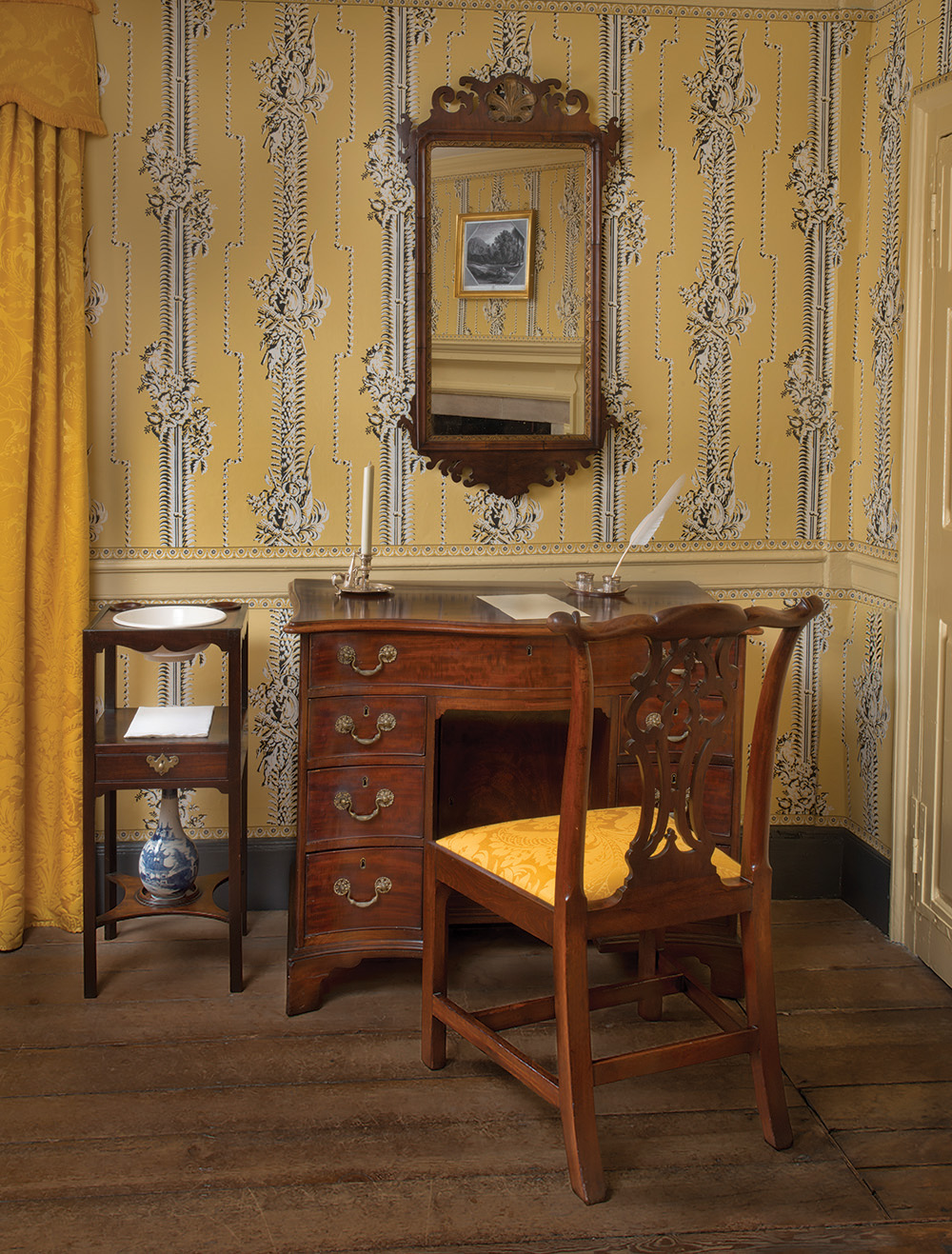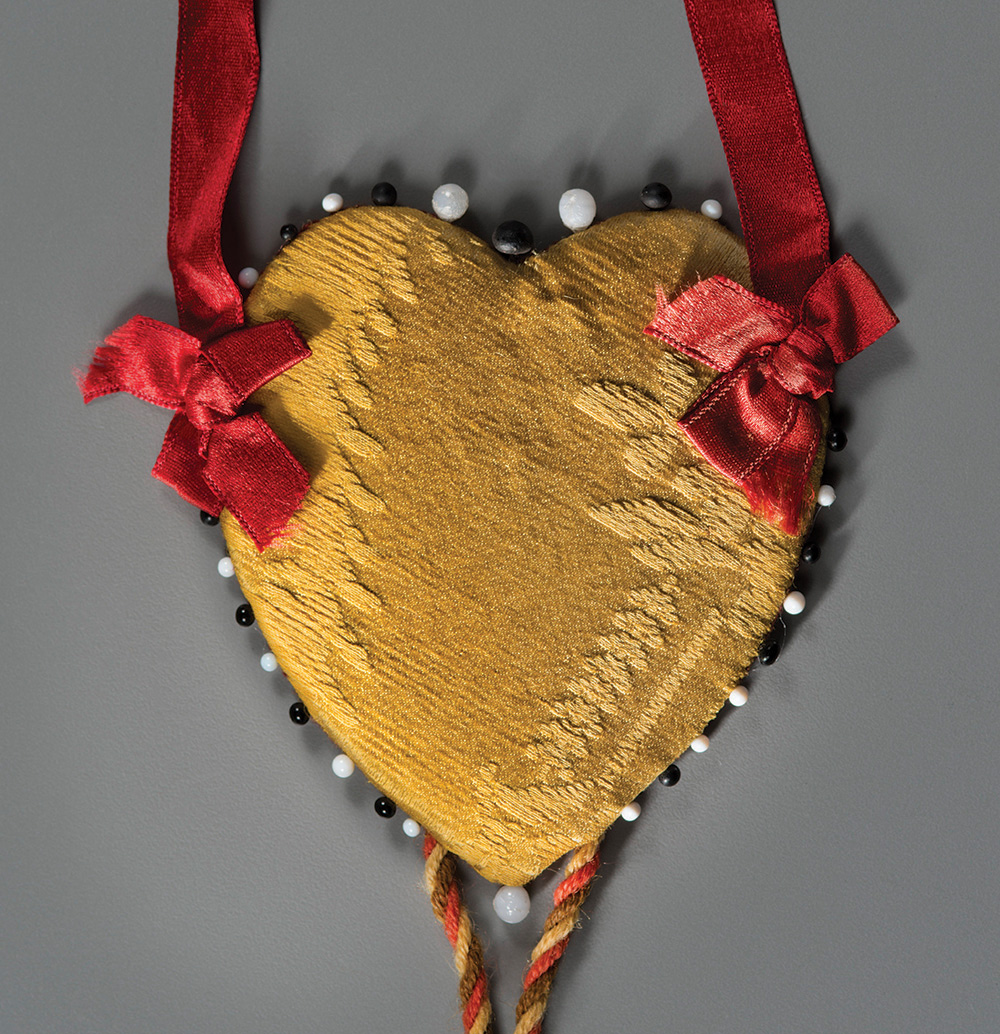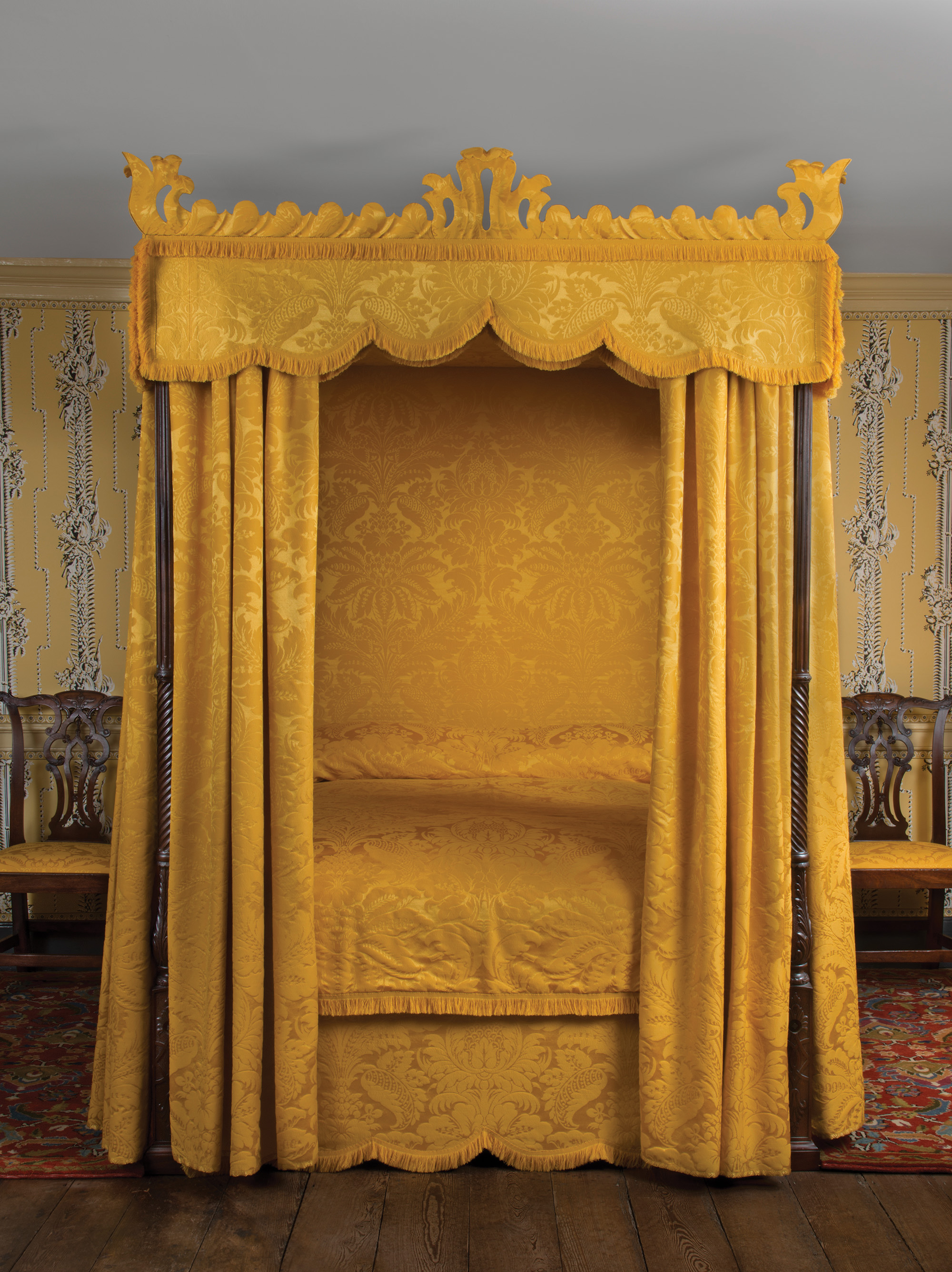
A newly unveiled reinterpretation returns Mount Vernon’s “best bedchamber” to its former glory
Overnight guests in 1799 would have easily recognized the Yellow Room as Mount Vernon’s best bedchamber. Those invited to lodge here would have felt suitably honored; it was resplendent with shimmering gold-toned damask throughout, a grand cornice-crowned bed, carved mahogany furniture, stately striped neoclassical wallpaper, a colorful bedside carpet, and gilt-framed art prints.
But the furnishings, and the room itself, underwent many changes over the years. An exciting and painstaking course of historical detective work enabled curators to decipher the clues to re-create this space, offering 21st-century visitors a chance to enter and experience Mount Vernon’s best bedchamber for themselves.
Evolution of a Room
Situated on the second floor overlooking the river, the Yellow Room first took shape with George Washington’s first major building campaign, which began in 1758 and likely continued into the 1760s. From it, guests enjoyed glorious sunrise views over the Potomac. The window, floors, wood trim, and north door (on the central passage side) that are still in place date to this period. When the south wing of the house was added in 1775, the room underwent further changes, some of which remain visible in the room: an updated mantel and a closet in the south wall, and the closing of any earlier window or door openings in that wall. A few years later, the addition of the overhanging roof for the piazza cut the light coming into the room, but the east-facing window continued to offer guests a glorious view of the sunrise over the Potomac.
The furnishings of the Yellow Room changed many times over the course of the Washingtons’ 40-year residency. Specific pieces in the Yellow Room in those early decades cannot be identified, but it served as a bedchamber for visiting family and guests, including one noteworthy visitor—Martha Washington’s granddaughter, Elizabeth (Eliza) Parke Custis Law. The 15-year-old Eliza etched her name and the date, “August 2, 1792,” into a window pane.
The Washingtons likely refurnished the Yellow Room in 1797 as part of comprehensive renovations to the Mansion, which included painting and wallpapering. The probate inventory taken after George Washington’s death documents the contents of the room in this late period, briefly listing the types of furnishings and their values. A superficial reading might suggest that the contents of this room were no different from those in the other bedchambers—each equipped with a bed, dressing table, mahogany chairs, carpet, mirror, and a few prints. Significantly, however, the values given for the bed, table, and chairs of the Yellow Room were greater—the first of several clues that, together with a comprehensive analysis of documentary and material culture evidence, revealed that this bedchamber stood above the rest.
In elite households of the 18th century, the best bedrooms were typically designated for guests of the highest social stature, a pattern established centuries earlier by English aristocrats who constructed elaborate, little-used state bedchambers to house royalty or high-ranking nobles. Well-to-do Americans echoed this practice: the best bedchambers were often marked by an impressive bed draped in fine imported fabrics, whose cost frequently made this piece the most expensive single item in a household.

The dressing table and washstand catered to the comfort of guests in the Yellow Room. Bureau dressing tables or desks were multifunctional, sometimes with fitted drawers to facilitate both grooming and writing. The stand holds the water jug and basin needed for daily cleansing of hands and face.
(Photo by Gavin Ashworth)
Rediscovering the Yellow Damask Suite
The high value assigned to the furnishings identified this room as the best bedchamber in the Mansion in 1799, reserved for guests of honor. But what might the original furnishings have looked like? As the investigation began, no original pieces from the Yellow Room had been conclusively identified.
The room’s name gave an important clue. Both George and Martha Washington referred specifically to the “Yellow Room” in their writings. In the 18th century, room names typically referred to the color and type of upholstery in a room, and the wall finishes complemented these fabrics. Yellow upholstery and yellow walls, then, would have defined the space.
Curators searched for likely candidates that fit the profile: a relatively high-end, yellow upholstered bed; mahogany chairs; and a fine dressing table. They used the Washington Material Culture Database, a landmark research tool created over the past five years that contains all known historical documentary references to the furnishings and tools used at Mount Vernon. The search took them back to August 1757, when Washington’s English agent shipped him everything needed to create a best bedchamber at Mount Vernon, equivalent to the fashionable interiors of London. The invoice listed “A Bedstead with Mahagony Carvd & fluted pillars for feet Posts, yellow Silk & Worsted Damask Furniture, lin[e]d with Tammy, & Carvd Cornishes compleat.” This last detail referred to a carved cornice covered with yellow damask, a distinguishing feature of this particular bed. While not as elaborate as a gilt cornice, it nevertheless represented the higher end of bed finishing options in the mid-18th century, above plain cornices of wood molding, painted pieces, or cornices with cut-out, pierced work. Also included in the order were three sets of yellow damask window curtains, a yellow damask easy chair, six “Gothic arched” back mahogany side chairs and an armchair, a “fine neat Mahagony Serpentine dressing Table,” a carpet, and, topping it off, crimson and yellow wallpaper.
When the suite arrived in the spring of 1758, Washington likely installed it in the northeast corner room on the first floor, overlooking the river. In 1797, the Washingtons transformed that room from a bedchamber into the Little Parlor, gaining more space for entertaining, and in particular, for granddaughter Eleanor (Nelly) Parke Custis’s splendid new harpsichord. What happened to the yellow damask suite at that point? The evidence points to a new home, above the stairs.


Fragments of the original bed survive, including a piece of the original silk and wool damask, made into a valentine in 1913 (above), and an original bedpost (left), with its acanthus carving.
(Damask photo by Gavin Ashworth; bedpost photo by Walter Smalling)
Undoubtedly, fitting the suite for its new space necessitated alterations. Carpenters such as John Neale (hired) and Isaac (enslaved) would have had to disassemble the bed frame and move it upstairs, where they would likely have had to cut down the bedposts to accommodate the lower ceiling. For the single, smaller window in the Yellow Room, Mrs. Washington could have directed enslaved seamstresses Charlotte and Caroline Branham to adapt the yellow damask cloth to make a new set of window curtains. They may also have had to shorten the bed curtains to adjust them to the shortened posts. While the utmost care would have been taken to preserve the textiles, the seamstresses likely would have also had to darn worn spots and tears in the fabric.
At least two more moves lay in the bed’s future. It moved to the third floor after George Washington’s death, and then to nearby Woodlawn, when granddaughter Eleanor (Nelly) Parke Custis Lewis inherited it. Each change required alterations for a new location.
Astoundingly, portions of the yellow damask bed have survived, and these helped guide the re-creation of the suite for the Yellow Room. The original bedstead, on loan from the Smithsonian’s National Museum of American History, endures in the form of two shortened, carved mahogany footposts and a side rail. In addition, small fragments of the yellow silk and wool damask, incorporated into a valentine in the early 20th century, provide a glimpse of the quality and brilliance of the original upholstery.
Cross-section paint microscopy, or paint analysis, using more advanced technologies than available in previous decades, led to a new understanding of the 1799 color of the woodwork in the room. Results indicate that, after 1775, the woodwork was painted a cream color, a shift to a neutral palette evident on woodwork throughout the house, and indicative of the Washingtons’ desire to keep up with the times It also strongly suggests that the Washingtons continued to use wallpaper befitting the room’s name.
Curators consulted with wallpaper historians to choose an appropriate pattern, since no fragments of the original survive. Looking at both documentary and material culture evidence of yellow damask bedchambers in the trans-Atlantic world, curators found that a popular pairing for yellow damask fabric was a yellow-ground paper with a grisaille (gray-scale) pattern. A neoclassical paper featuring military trophies on palm-frond columns found at the Theodore Lyman House in Wells (now Kennebunk), Maine, and preserved at Colonial Williamsburg and Historic New England, provided an example for reproduction by Adelphi Paperhangings, Inc.
Putting It All Together
To re-create the Yellow Room’s en suite furniture, curators assembled a combination of period and reproduction furnishings made by an expert team of artisans. Since the bedstead had undergone numerous changes over the years, curators elected to reproduce it as the Washingtons’ would have known it in 1799, with the crowning feature of a carved and upholstered cornice. Period furnishings were chosen that closely resembled the documentary descriptions of the missing dressing table, chairs, looking glass, and wash basin stand and set. Reproductions were also used to re-create light-sensitive textiles, wallpaper, and prints.
Documented 18th-century examples guided the detailing of each element of the Yellow Room’s reproduction bedstead. Cabinetmaker Harrison Higgins meticulously carved the mahogany bedpost and constructed the frame. Curatorial experts in England pointed out a superb period bedstead at Audley End, in Essex, as a suitable model for the now-missing carved cornice; its acanthus scrolls and bold gadrooning are characteristic of the rococo exuberance of the mid-18th century.
Making the bed frame was just the beginning, however. Natalie Larson of Historic Textiles, Inc., designed the yellow damask bed hangings and accompanying window curtains based on period examples at Delaware’s Winterthur Museum. Expert cutting and placement show off the abundant pattern of the damask, from the covered cornice to the majestic back panel known as the head cloth. The fabric itself was woven by Gainsborough Silk Weavers from historical designs.
Carpeting was a luxury in the 18th century, and even in the homes of the elite, small bedside rugs, rather than wall-to-wall carpeting, covered the floors. For the Yellow Room, David Bamford Hand Woven Carpets produced a brilliant crimson carpet based on a documented English “Persian” pattern with floral designs inspired by textiles from eastern Persia (encompassing parts of modern-day Iran and Afghanistan).
Four gilt-framed engravings provided the finishing touch, identified through Washington’s detailed list of “Prints purchased” in 1797, together with the probate inventory. The pair Morning and Evening, and a third print, The Young Herdman, are meditations on the pastoral life by Dutch artists Aelbert Cuyp and Adam Pynacker, with a focus on the gentle beauty of cattle. The final print may at first glance appear to be just another landscape. But a closer look reveals this to be The Flight, a copy of a painting by French artist Claude Lorraine depicting the Holy Family pausing to rest on their flight to Egypt to escape Herod’s rage. Beyond decoration, fine art prints such as these were intended to delight, instruct, and provoke conversation. In the Yellow Room, these works of art set a cosmopolitan tone and invited inspection and discussion by viewers.
A Room of Honor
Though additional architectural work remains, including conservation of the firebox and window, the Yellow Room’s position in Mount Vernon’s bedchamber hierarchy, relative to the less elaborate Chintz and Blue Rooms, comes into clear focus. From the gold-toned damask and the dramatic cornice-crowned bed frame to the intriguing prints and stately striped neoclassical wallpaper, today’s visitors get to fully experience this room of honor as the Washingtons intended.

The cornice-crowned, damask-covered bed in Mount Vernon’s “best bedchamber.”
(Photo by Gavin Ashworth)
Amanda Isaac is Mount Vernon’s associate curator.
This project was made possible by the generous support of the Connoisseur Society, as well as The Brown Foundation, Inc., Jim and Jo Carol Porter, the George L. Shields Foundation, Inc., Russell B. Adams, Jr., and hundreds of donors from across the country.